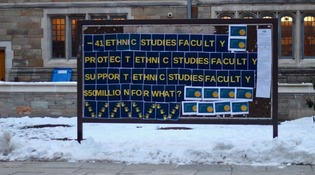 loading
loading
Light & VerityEthnic studies program gets new statusFaculty hiring power will offer more stability for a program popular with students.  Coalition for Ethnic Studies at YaleStudents took over a campus bulletin board in March to protest what they said was Yale's lack of support for ER&M. View full imageAt the end of March, the tenured faculty of Yale’s program in ethnicity, race, and migration (ER&M) announced that they would “withdraw their labor” from the program after they had shepherded current juniors and seniors to graduation. The professors were frustrated by what they saw as a lack of support from the administration about the program’s needs and its future, particularly regarding the appointment and promotion of faculty. Just a month later, the department and the university announced a resolution. The university committees that oversee faculty positions made the faculty slots allotted to the program more permanent—and gave the program the power to appoint its own faculty, as many other programs and departments do. In response, the faculty elected to recommit to the program. The ER&M professors’ action had led to letters of support from ethnic studies faculty around the country and student protests on the program’s behalf. ER&M chair Alicia Schmidt Camacho believes the program has students to thank for the university’s increasing commitment to the program. But Faculty of Arts and Sciences dean Tamar Gendler ’87 says the resolution wasn’t the result of protests. “The university had already been engaged in a review of a related program, American studies—a process that had begun more than a year before,” says Gendler. “This backdrop allowed a quick resolution to the ER&M situation.” Ethnicity, race, and migration is an interdisciplinary program that looks at groups of people across geographic lines. Its faculty come from many disciplines, including history, American studies, anthropology, and sociology. Anthropologist Zareena Grewal, for example, studies communities in the Muslim diaspora in the US, Europe, the Middle East, and South Asia. Yale’s ER&M program traces its origins to its American studies program. But the field has come to transcend national boundaries. “In the last 20 years there’s been a realization that the study of ethnicity, race, and migration is a distinct intellectual endeavor,” says Gendler. “It’s not just American; it’s transnational.” Since 1997, undergraduates have been able to declare ER&M as a second major; in 2012, it became a stand-alone major. The major has become increasingly popular, attracting between 20 and 30 students in each class year. The perception that the program is undersupported played a part in the student activism around racial issues in 2015. In November of that year, Yale agreed to create four faculty positions for ER&M. But Schmidt Camacho, a professor of American studies and ER&M, says the new positions weren’t being filled in a way that was sustainable for the program. The faculty were appointed through other departments, giving ER&M little control over the tenure process and little ability to manage faculty service efforts (such as service on committees in other departments) that cut into teaching time. “When I became chair last fall, it became clear to me I did not have the status of a chair. I could not do what other chairs could do, and there was no plan for the program’s growth and permanence,” says Schmidt Camacho. She says that when the faculty in the program tried to clarify its status, the university administration didn’t respond. The 13 tenured faculty in the program decided unanimously that they couldn’t go on. “We were not able to plan effectively for next year,” says Schmidt Camacho. “There was the real issue of the integrity of the program.” The program’s six faculty slots—which before had been guaranteed to ER&M only for the tenure of the incumbent faculty—have been allocated to the program on a more permanent basis. Additionally, the faculty that the program appoints may now be assigned solely to ER&M. That’s significant both because it gives the program more autonomy and because the demands of multiple departments and programs are difficult for junior faculty to fulfill while they’re working toward tenure. “We hire, we present [the candidate’s] case, we have a say in salary and service requirements,” says Schmidt Camacho. The change puts the program on a new footing in relation to other universities. “None of our peers has ER&M self-standing in this way,” says Gendler. “We are by far the most robustly structured in this field.”
The comment period has expired.
|
|